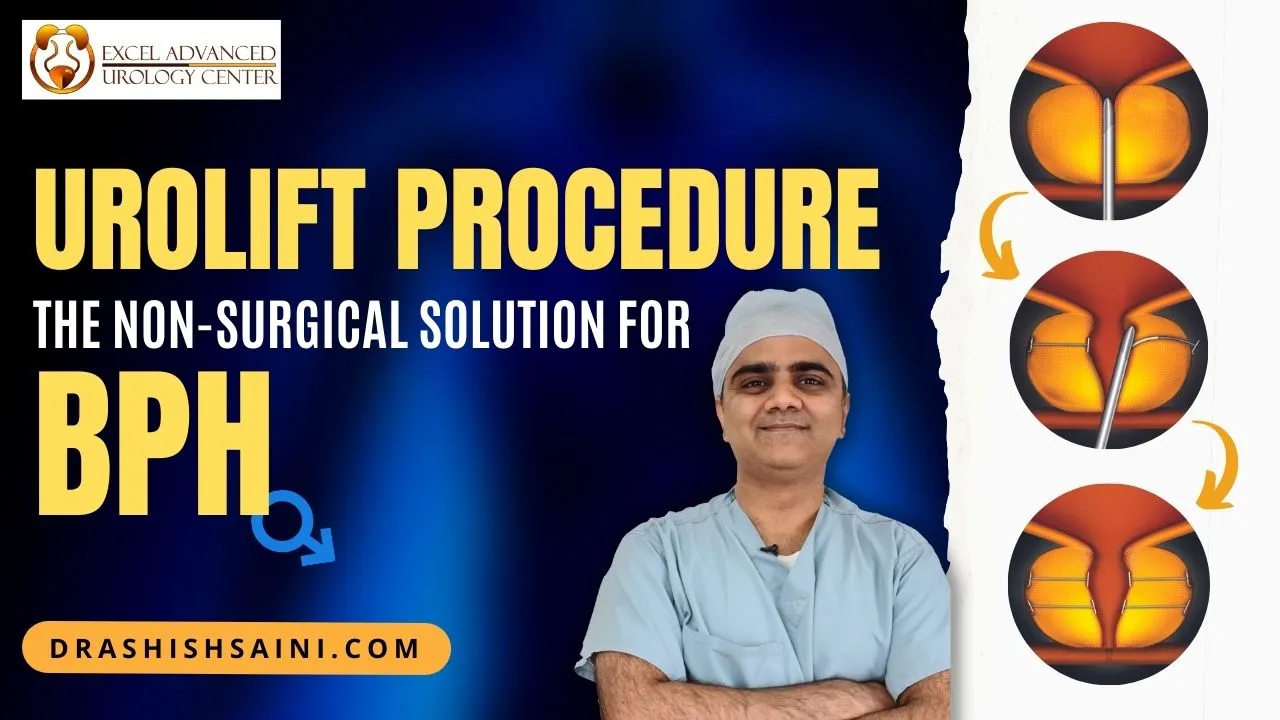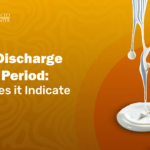

If you or someone you know is experiencing symptoms related to an enlarged prostate, then you’ve come to the right place. We understand that discussing urological issues can be uncomfortable, but we believe that education on UroLift Procedure is the key to making informed decisions about your health.
Here, you will get a detailed understanding of what the UroLift Procedure is, how it works, the benefits and risks, and what to expect before, during, and after the procedure. Dr Ashish Saini, a renowned urologist in Delhi, specializes in cutting-edge treatments of BPH. With his extensive expertise, patients from India and abroad have received advanced and successful care.
Let’s take a walk through the procedure and its effectiveness.
What is UroLift Procedure?
The UroLift Procedure is a simple medical procedure that involves using small implants to lift and secure the enlarged prostate tissue, allowing the urethra to remain unobstructed, thus effectively treating symptoms of Benign prostatic hyperplasia (BPH) and promoting quick recovery. This technique does not involve any cutting, heating, or removal of prostate tissue.
This procedure is unique in that it does not cause any long-term erectile or ejaculatory dysfunction, unlike other common methods for treating an enlarged prostate. Compared to surgical treatments, it has a lower risk of adverse effects, including major complications and extended painful recovery periods. As a minimally invasive treatment, the procedure offers a reliable alternative to medication or major surgery for individuals seeking relief from an enlarged prostate.
UroLift for Benign Prostatic Hyperplasia (BPH)
Benign Prostatic Hyperplasia (BPH) is a non-cancerous condition that is often associated with age in men. This condition causes the prostate gland to enlarge, leading to compression or partial obstruction of the adjacent urethra, resulting in painful urination. According to research, BPH affects over 40% of men in their 50s and over 70% of men in their 60s.
Although BPH is a benign condition and not related to prostate cancer, it can still significantly impact daily activities. If left untreated, an enlarged prostate can lead to permanent bladder damage. It is important to note that BPH is not the same as prostate cancer, and it is recommended to consult with a specialist to receive accurate information and clear up any misconceptions about prostate cancer. The UroLift procedure is a treatment of BPH option available for individuals, offering relief from urinary symptoms and improved quality of life.

Before receiving BPH treatment, it is critical to be aware of the symptoms.
Who are the candidates for UroLift Treatment for BPH?
The ideal candidates for UroLift Procedure are men who are experiencing lower urinary tract symptoms due to an enlarged prostate, also known as Benign Prostatic Hyperplasia (BPH). The procedure is particularly suitable for those who prefer a minimally invasive approach to surgery, want to avoid medications or more invasive surgical procedures, and wish to retain their sexual function. It is essential to consult with a qualified urologist to determine if UroLift treatment is the right option for your specific case.
Symptoms of BPH Before Treatment:
Before treatment of BPH (benign prostatic hyperplasia), the following symptoms may be experienced:
- Urinary Incontinence: A sudden, urgent feeling of needing to urinate.
- Frequent Urination: The need to urinate frequently during both the day and night.
- Difficulty Starting Urination: Difficulty or delay in initiating urination.
- Weak Urinary Stream: A weak or slow urinary stream.
- The feeling of Incomplete Emptying: A sensation that you cannot fully empty your bladder.
- Intermittent Urination: A urine stream that starts and stops.
These symptoms can have a significant impact on an individual’s quality of life and may require medical intervention to manage. If you experience any of these symptoms, it is recommended to consult with a healthcare provider for proper diagnosis and treatment of BPH.
How is the UroLift Procedure Performed for the treatment of BPH?
The UroLift procedure for benign prostatic hyperplasia (BPH) involves three main steps:
Step 1- Inserting the UroLift Delivery Device: The UroLift Delivery Device is inserted through the blocked urethra to reach the enlarged prostate. This is a minimally invasive procedure that does not require any incisions. The device allows the surgeon to access the prostate and perform the UroLift system with precision and accuracy.
Step 2- Implanting UroLift Implants: During the UroLift procedure, small UroLift implants are surgically placed to lift and hold the enlarged prostate tissue out of the way. These implants are made of a special material that is safe for the body and will not cause any adverse reactions. The implants are designed to provide long-lasting relief of symptoms associated with BPH.
Step 3- Withdrawing the UroLift Delivery Device: After the implants are placed, the UroLift Delivery Device is removed, leaving an open urethra. This allows for normal urine flow and alleviates the symptoms associated with BPH. The entire UroLift procedure typically takes less than an hour to complete and is performed on an outpatient basis, allowing patients to return home the same day.
The procedure is typically performed in a doctor’s office or outpatient setting and can be completed quickly with minimal pain or discomfort. It is a minimally invasive alternative to traditional surgical methods for treating BPH, with a shorter recovery time and fewer risks of complications.
In most cases, 4-6 implants are used per patient.

Advantages of UroLift Procedure:
The UroLift procedure for Benign Prostatic Hyperplasia (BPH) offers several advantages over other treatment options:
- No Continuous Medications: Unlike other BPH treatments, such as medication therapy, there is no need for continuous medication after the UroLift procedure.
- Quick Recovery: Patients can typically resume normal activities within a few days after the procedure.
- Lower Risk Profile: The UroLift procedure carries a lower risk of complications compared to surgical techniques like transurethral resection of the prostate (TURP).
- Rapid Symptom Alleviation: Patients usually experience a rapid and significant improvement in BPH symptoms, which is often superior to the relief provided by medications.
What are the Expectations for the UroLift Procedure?
Before the Procedure:
- The urologist will provide detailed information about the UroLift surgery and the procedure.
The procedure may be performed under local anaesthesia.
During the Procedure:
- The urologist will insert a small tube through the urethra and place implants into the prostate to create a wider opening for urine to flow more easily.
After the Procedure:
- A catheter is typically not required after the procedure.
- The most common temporary side effects of the procedure include painful urination, blood in the urine, pelvic discomfort, urinary urgency, and difficulty controlling the urge to urinate.
- Rare side effects such as bleeding and infection may occur, but these are infrequent and can usually be treated effectively.
- Most symptoms usually subside within two to four weeks following the procedure.
The UroLift treatment is a safe and effective option for treating BPH, with a quick recovery time and minimal risks of complications. Patients can expect a significant improvement in their symptoms and a return to normal activities within a few days after the procedure. It is important to discuss any concerns or questions with the urologist before undergoing the procedure.
Precautions after the UroLift procedure for Prostate Enlargement
After undergoing the UroLift procedure for prostate enlargement, it is important to take certain precautions to ensure proper healing and reduce the risk of complications. These precautions include:
- Avoiding intense activities such as heavy lifting, biking, and treadmill exercise for the first two weeks after the procedure to minimize the risk of bleeding or discomfort.
- Refraining from sexual activity for at least two weeks to allow the prostate time to heal.
- Drinking plenty of water to stay hydrated and help flush out any residual blood or debris in the urinary tract.
Additionally, patients should follow any specific instructions or recommendations provided by their urologist regarding pain management, follow-up appointments, and any necessary medications. By following these precautions and guidelines, patients can minimize the risk of complications and achieve the best possible outcomes from the procedure.
5 Reasons Why You Should Choose Urolift Procedure
There are several reasons why the UroLift procedure may be the best choice for those seeking treatment for BPH:
- Safer than surgery: This procedure is quick, effective, and safe, with minimal risk of complications. Compared to more invasive treatments, such as surgery, there is a lower risk of infection, bleeding, incontinence, and sexual side effects. Recovery is also faster, measured in days instead of weeks.
- No need for medication: BPH medication can produce a range of side effects, from dizziness to sexual dysfunction. Moreover, they may not provide adequate symptom relief, and the prostate may continue to grow. UroLift surgery eliminates the need for medication and the associated side effects.
- Preserves sexual function: Many BPH treatments can cause sexual dysfunction, but UroLift does not. Unlike other standard treatments such as TURP, pharmaceutical, laser, and heat-based therapies, UroLift treatment keeps your sexual function intact.
- Improves quality of life: UroLift treatment for BPH can significantly improve your quality of life within just a few weeks. You can resume your normal activities and no longer must plan your day around bathroom availability. The procedure is a one-time event and does not require regular maintenance, which further improves the quality of life.
- Faster Recovery Time: The uroLift procedure has a faster recovery time compared to traditional surgical methods such as Transurethral Resection of the Prostate (TURP). With UroLift, most patients can return to their daily activities within a few days, whereas TURP requires a longer recovery period.
UroLift versus TURP
Two common treatments for BPH are UroLift and Transurethral Resection of the Prostate (TURP). While both procedures aim to alleviate BPH symptoms, they differ in several ways.
- Treatment Procedure: UroLift treatment is a minimally invasive procedure that uses small implants to hold the prostate lobes apart, creating an unobstructed pathway for urine flow. The procedure is typically performed under local anaesthesia and can be done in a urologist’s office or an outpatient surgery center.
TURP, on the other hand, is a more invasive procedure that involves removing part of the prostate gland through the urethra. The procedure is performed under general or regional anaesthesia and requires a hospital stay of one to three days. While TURP has a high success rate in relieving BPH symptoms, it also carries a higher risk of complications such as bleeding, infection, and sexual dysfunction.
- Recovery Time: In UroLift treatment patients experience a rapid improvement in symptoms, and recovery time is usually brief, with most patients resuming normal activities within a few days. While in TURP surgery the recovery time is longer, with most patients requiring several weeks to resume normal activities.
- Impact on Sexual Function: While TURP has been shown to increase the risk of sexual dysfunction, UroLift has a low risk of sexual side effects. UroLift has also been shown to preserve erectile and ejaculatory functions, making it an attractive option for men who wish to maintain their sexual health.
Urolift Surgery: A Safe and Effective Alternative
The UroLift prostate procedure is a safe and effective alternative to traditional surgical treatments for BPH, with minimal risks and faster recovery times. Patients who undergo UroLift surgery experience significant improvements in symptoms and quality of life while preserving their sexual function.
Dr. Ashish Saini: Your Skilled Urologist
If you are experiencing symptoms of BPH, it is important to consult with a qualified urologist and book an appointment with Dr Ashish Saini at Excel Advanced Urology Center in Delhi. As a skilled urologist and andrologist in Delhi, he has successfully performed many urological procedures, including UroLift, and is trusted by his patients for his expertise and compassionate care.
Don’t let BPH affect your quality of life any longer. Take the first step towards a healthier, happier future.
FAQ’s
1. What is the UroLift procedure?
The UroLift procedure is a minimally invasive treatment for BPH that uses small implants to lift and hold the enlarged prostate tissue out of the way, improving urinary symptoms.
2. What are the symptoms of BPH?
Symptoms of BPH include frequent urination, weak urine flow, difficulty starting urination, and the need to urinate urgently.
3. How effective is Urolift?
Yes, UroLift is a safe and effective treatment for obstructive prostate tissue in many men. It relieves lower urinary tract symptoms caused by BPH without interfering with a man’s sexual function. It is best to consult with a qualified urologist to determine if UroLift treatment is the right treatment option for you.
4. How does the Urolift system procedure work?
The UroLift system works by inserting a delivery device through the blocked urethra, and small implants are surgically placed to lift and hold the enlarged prostate tissue out of the way, relieving the symptoms. The device is then withdrawn, leaving an open urethra.
5. Is the UroLift procedure painful?
The pain is mild and recovery is relatively short, with most men not needing to use a catheter during recovery.
6. How long does the UroLift procedure last?
The UroLift procedure typically takes 10 to 15 minutes to complete.
7. What is the success rate of the UroLift procedure?
The UroLift procedure has a high success rate and can effectively relieve symptoms in many men with BPH.
8. Can Dr Ashish Saini provide Urolift Procedure?
Yes, Dr Ashish Saini is a highly qualified urologist at Excel Advanced Urology Centre who has extensive experience treating BPH using a variety of minimally invasive and reconstructive surgery methods.
9. How much does UroLift cost in India?
The cost of the UroLift procedure can vary depending on the location and healthcare provider but is generally around $5500 in India.
10. Does the UroLift procedure affect sexual function?
The UroLift procedure does not typically cause sexual dysfunction, unlike many other BPH treatments.






